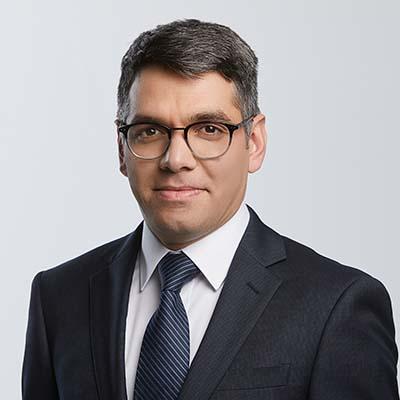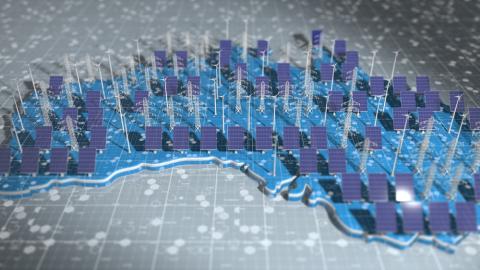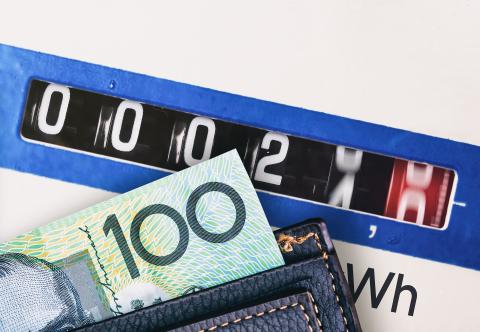Australia faces growing green iron competition from overseas
Download Full Report
View Press Release
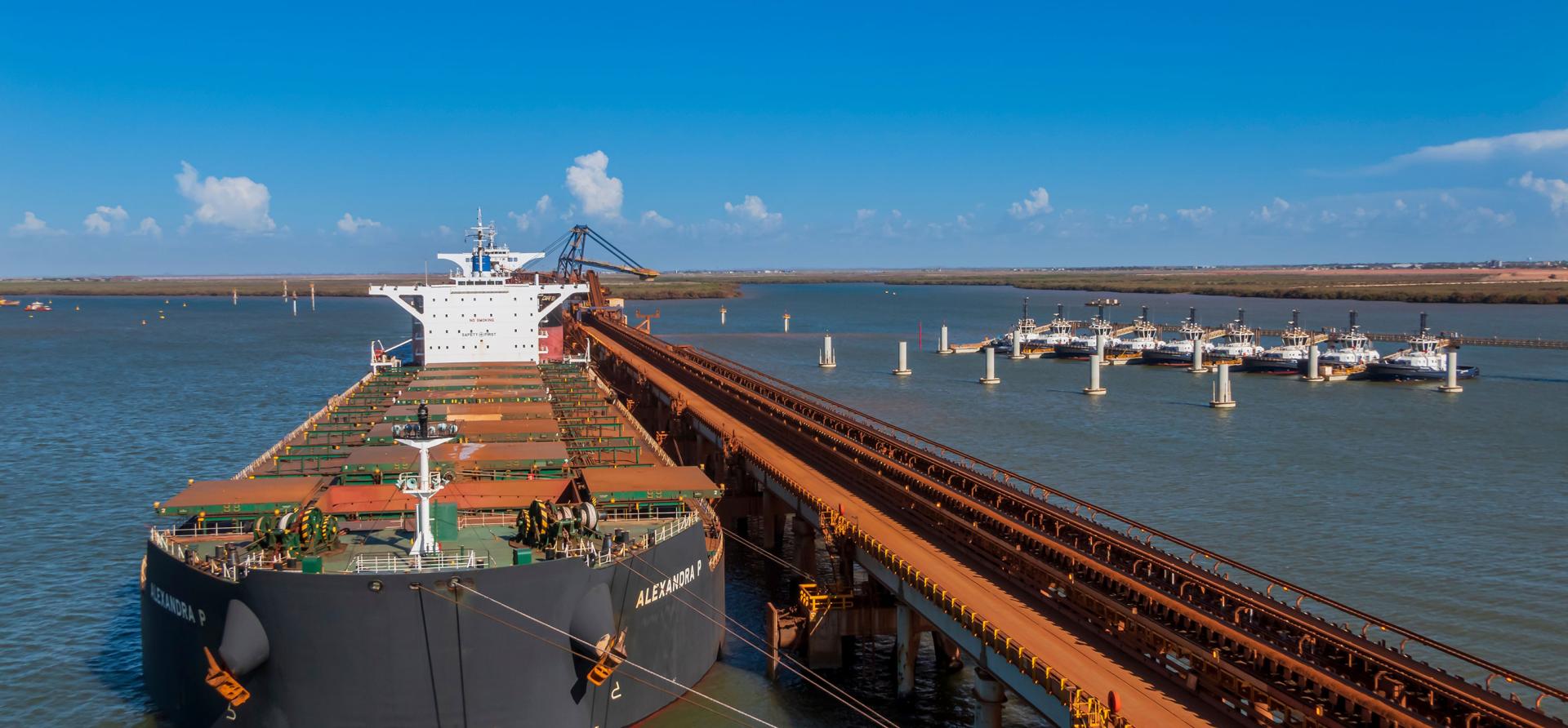
Key Findings
Australian iron ore faces growing competition in the emerging green iron market from countries and regions that produce higher-grade ore better suited to non-coal-based steelmaking.
The cost of shipping green hydrogen means it should be used at the place of production wherever possible. Australia has an opportunity to shift towards onshore processing of iron ore using green hydrogen to produce low-carbon iron for export.
The global steel sector is considering a future that involves shipping green iron rather shipping both green hydrogen and iron ore. Brazil, the Middle East and Africa are in a prominent position for producing green hydrogen-reduced iron.
Technology developments that allow the use of Pilbara iron ores in low-carbon ironmaking using direct reduced iron (DRI) processes need to be accelerated to prevent Australian iron ore losing market share to other countries and regions that are also eyeing this opportunity.
Executive Summary
Australian iron ore – the nation’s biggest export – risks losing ground to other nations in the accelerating global shift towards green iron and low-carbon steel if research and development projects are not sped up.
With carbon capture technology looking unlikely to play a major role in steel decarbonisation, steel companies are increasingly planning a shift away from coal-consuming blast furnaces towards direct reduced iron (DRI) technology that can run on green hydrogen.
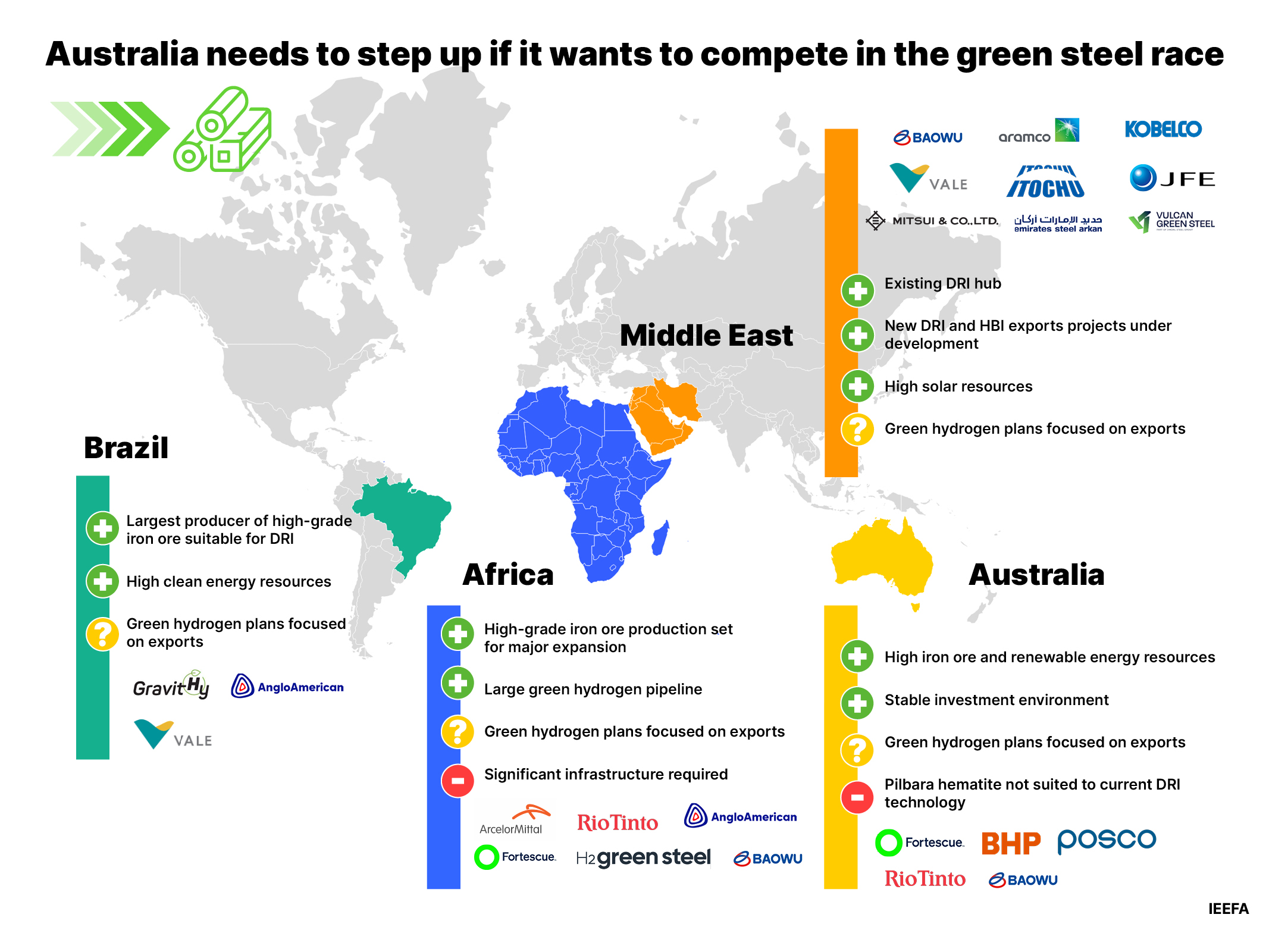
A recent report from the Minerals Research Institute of Western Australia (MRIWA) found that a global steel industry shift away from coal towards DRI on a pathway to net zero emissions steelmaking presents “a material, structural change to Western Australia’s iron ore industry, and the economy more broadly”. It also highlighted that, in a scenario where the steel technology transition is accelerated, Western Australia’s iron ore industry would be “in a precarious position assuming no change to the current product mix”.
Australia faces a distinct disadvantage due to the quality of its hematite iron ore compared with other nations. DRI-based steelmaking currently requires ores with a high iron content, typically 67% or more. Most of the Pilbara’s commercial deposits contain between 56% and 62% iron, currently suitable only for incumbent, highly carbon-intensive blast furnace technology.
Given the inefficiency and cost of shipping green hydrogen or green ammonia, it makes sense to use more of this planned production domestically to produce value-added products like green iron from iron ore.
There is a growing focus on the development of a major green hydrogen production and export industry in Australia. However, given the inefficiency and cost of shipping green hydrogen or green ammonia, it makes sense to use more of this planned production domestically to produce value-added products like green iron from iron ore.
Green iron – made via DRI and exported as hot briquetted iron (HBI) – is now being considered for import by major global steelmakers instead of importing both iron ore and green hydrogen, as part of decarbonisation plans for an industry currently based on the import of iron ore and metallurgical coal. In its assessment of options for Western Australia’s iron ore industry to position itself for a decarbonising steel sector, the MRIWA found that, “pathways which involve the development of intermediate iron products, such as HBI, are the most prospective for Western Australia.”
South Korean steel giant POSCO is considering a US$40bn investment in Australia with US$28bn earmarked for green hydrogen production and a further US$12bn for the production and export of green HBI. Japan’s largest steelmaker, Nippon Steel, is considering a US$700m investment in hydrogen-based green steel outside Japan with Australia a possible location. In addition, China Baowu Group – the world’s largest steelmaker – is considering a major green iron project in Western Australia.
However, in a sign of the growing competition Australia faces as steelmakers start thinking about the offshoring of green iron production, both China Baowu and Nippon Steel are considering other locations. China Baowu is also looking at South America, Africa and the Middle East as possible green iron/steel investment locations and has signed an agreement with Aramco and the Saudi Public Investment Fund to set up a DRI-based steelmaking plant in Saudi Arabia to supply the domestic and regional market. Nippon Steel is considering Brazil – with its high-quality iron ore reserves – in addition to Australia.
Although Australia leads the world in iron ore exports, other nations and regions have the opportunity to combine their higher-grade iron ore and renewable energy resources to produce green iron for export in response to future demand growth.
Brazil
Brazil is the world’s largest producer of high-grade iron ore and has significant renewable energy and hydro power resources. As such, Brazil is in a position to produce green hydrogen at a competitive price compared with many other regions as hydrogen electrolyser costs come down.
Brazilian iron ore miner Vale – the world’s leading producer of direct reduction-grade (DR-grade) iron ore – considers that it has an advantage over the other major iron producers when it comes to the steel technology transition towards DRI-based steelmaking. Its DR-grade ore can be used in standard and well-established DRI-electric arc furnace (DRI-EAF) steelmaking operations without the need for an additional melting furnace step required to enable the use of blast furnace-grade ore (such as that produced in the Pilbara) in DRI processes.
In May 2023, Vale announced it had signed a memorandum of understanding (MoU) with GravitHy to jointly evaluate a hydrogen-based DRI plant in France. The intention is to begin production as soon as 2027 with Vale supplying the DR-grade iron ore. The DRI produced is planned to be used directly or traded globally as HBI. In August 2023, H2 Green Steel – which is aiming to produce steel using green hydrogen from 2025 – agreed a multi-year deal with Vale that will see it supply the steelmaker with DR-grade iron ore pellets. H2 Green Steel also made a similar agreement with Rio Tinto, which will supply pellets from its Canadian – not Australian – operations. The deal will also see Rio buy and on-sell HBI from H2 Green Steel.
Middle East
The Middle East is already a hub of DRI-based steelmaking based on the region’s plentiful gas supply and has an opportunity to convert its steel industry from gas to green hydrogen utilising the region’s abundant solar resources. This prospect is already drawing interest from steelmakers and miners, who are eyeing the region becoming a green iron hub based on growing DR-grade iron ore supply from Vale.
In addition to China Baowu’s agreement with Aramco, Japanese companies Kobe Steel and Mitsui & Co. have signed a MoU to explore the feasibility of DRI production and export as HBI from Oman beginning in 2027. Vulcan Green Steel plans to invest US$3 billion in a DRI-EAF plant with the annual capacity of 5 million tonnes in Oman. The company is targeting low-carbon steel demand in the Middle East, Europe and Japan. In the UAE, Emirates Steel Arkan has partnered with Japanese steelmaker JFE Steel and trading house Itochu Corporation in a plan to produce DRI in Abu Dhabi for shipping to Asia from 2025.
Africa
Although a smaller iron ore producer, Africa already produces grades of higher quality than Australia and there is the prospect of much more to come, including from Australian companies that are now shifting into the continent. Africa also has well over 100 gigawatts (GW) of green hydrogen capacity in the pipeline.
The potential suitability of at least some African iron ore output for DRI-EAF steelmaking operations has been demonstrated by Anglo American’s recent MoU with H2 Green Steel. The agreement will see ore from Anglo’s South African and Brazilian operations trialled in H2 Green Steel’s DRI process in Sweden.
Africa’s most significant iron ore development is now moving forward in Guinea. In the coming years, Guinea looks set to become the third-largest iron ore producer in the world after Australia and Brazil, with a quality significantly higher than Australia’s. If the Simandou projects led by Rio Tinto and Chinese companies run smoothly, the deposits could produce 200 million tonnes per annum of high-grade, 65-66% Fe ore by the end of the decade. Rio Tinto has stated that the deposit is estimated to have 40% of high-quality iron ore resources that are “well suited to meet DRI specification and could be processed using the DRI-EAF route”.
Fortescue is also targeting high-grade iron ore in Africa and signed a Mining Convention in February 2023 with Gabon for the Belinga Iron Ore Project in the north-east of the country. The Belinga project is on course to deliver the first shipment of iron ore before the end of 2023. Former Fortescue CEO Fiona Hick has stated that “every indication we have, shows the project has the potential to be significant scale and very high-grade”, and that, “initial indications are that it could be similar in scale and size to Simandou in Guinea.”
Australia’s Iron and Steel Decarbonisation Challenge in Context
As well as contributing to the global supply of high-grade iron ore required as the steel technology transition away from coal accelerates, Simandou will also help China achieve its strategic aim to reduce reliance on Australian iron ore.
As the world’s largest steelmaker, China is the biggest importer of iron ore globally and Australia’s key iron ore export market. However, as the Chinese economy matures, its steel demand will enter long-term decline. Steel production in China has been declining since 2020, and there are early signs that production in 2023 will be below the previous year.
In addition, as well as developing Simandou with Rio Tinto, China is aiming to increase domestic iron ore production and increase recycling from scrap steel – a resource that will become increasingly available in China as its economy continues to mature. Increased recycling of scrap steel will be a significant steel decarbonisation tool going forward and represents a growing source of competition for Australian iron ore.
Within the context of these trends, Australia is challenged with the task of making its lower-grade iron ore suitable for DRI-based iron and steelmaking operations. This could include beneficiating Pilbara hematite iron up to DR-grade and a switch to more magnetite mining, which is more amenable to beneficiation up to a higher grade. Fortescue is already producing and shipping magnetite containing 67% Fe, which meets DR-grade.
In addition, steel technology developments will likely also be part of the solution. Rio Tinto, BHP and Fortescue are all investigating technology solutions that would allow the use of their blast furnace-grade Pilbara iron ore in DRI-based processes. Furthermore, both Fortescue and Rio Tinto have signed agreements with China Baowu to investigate steel emissions reduction. Both agreements will investigate the use of Pilbara iron ore in DRI-based steelmaking in China, while Rio Tinto’s agreement will also investigate the possibility of low-carbon iron production in Australia.
Australia has numerous advantages that present it with an opportunity to lead the global steel sector into a low-carbon future, including abundant iron ore and renewable energy resources, established infrastructure, and political and regulatory stability providing a strong investment environment. In addition, the sheer size of the Western Australian iron ore industry is a further advantage – the global steel sector will need Western Australian iron ore to be heavily involved in decarbonisation if net zero global steel emissions are to be achieved.
However, Australia faces multiple long-term iron ore challenges, and one of these is that Pilbara ore is generally well below the quality currently required for lower-emissions DRI-based processes. Research and development efforts need to be accelerated if Australia and its miners are to remain global leaders in iron ore and do not lose out amid growing demand for low-carbon iron and steel. Some refocusing of Australian green hydrogen projects towards more domestic use can help Australia lead the green iron export opportunity going forward.
The MRIWA noted that shifting towards green iron production “represents the greatest economic opportunity” for Western Australia when it comes to positioning the iron ore industry for a low-carbon future. It also warned of a possible scenario where “other global suppliers of iron ore and iron feedstock better position to succeed in a Green Steel world”, a scenario that becomes more likely if technology developments that allow the use of Pilbara hematite in DRI processes are delayed.


